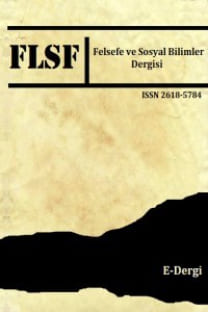MARTIN HEIDEGGER VE ARISTOTELES’İN SANAT GÖRÜŞLERİNİN İNCELENMESİ
Martin Heidegger, yorumbilgisel bir döngü ile sanatın kökenini varlık ve hakikat üzerinden açıklama yolunu izler. Diğer yandan Aristoteles, sanatın doğayı taklit ettiği görüşünü savunur. Bu yüzden ilk etapta Aristoteles’in sanat görüşünün Heidegger’inki ile zıt düştüğü algısı oluşsa da Aristoteles, üzerinden sanat görüşlerini temellendirdiği tragedyayı doğal varlıklarla bir görmez. Aksine, ‘karakter’ kelimesini çoğu zaman ‘karakterin ortaya konuşu’, ‘düşünce’ kelimesini de ‘dilde ortaya konan düşünce’ anlamında kullandığından, Aristoteles için şeylerin ilk etapta göründükleri gibi temsili değil, hakikatlerinin ortaya konması gerekliliği savunulabilir. Dahası, Heidegger’in ve Aristoteles’in sanat üzerine fikir birliğine vardığı konuların arasında şiirsel sanatların doğası ve sanat eserinin sanatçı ürünü olması görüşleri de sıralanabilir. Bu yüzden, Heidegger’in ve Aristoteles’in sanat görüşlerinin sanılanın aksine bir ortaklık taşıdıkları ifade edilebilir.
Anahtar Kelimeler:
Sanat, Heidegger, Aristoteles, hakikat, varlık
AN ANALYSIS OF THE VIEWS OF MARTIN HEIDEGGER AND ARISTOTLE ON ART
Martin Heidegger sets out to establish the source of art through being and truth by making use of a hermeneutic cycle. On the other hand, Aristotle holds the view that art imitates nature. Although this idea creates the impression that Heidegger’s and Aristotle’s views of art are opposite, Aristotle does not consider tragedy and natural beings equal. In contrast, since he uses the word ‘character’ as ‘the revelation of character’, and the word ‘thought’ as ‘the thought revealed in speech’, one might argue that, for Aristotle, the necessity to reveal the truth in beings predominates their representation as they appear at first glance. Moreover, among the topics that Aristotle and Heidegger take a similar stance on the issue of art, the nature of poetics art can be considered. For that reason, one might hold the view that the views of Heidegger and Aristotle on art share common points, despite the common belief.
___
- Aristoteles. (2018). Poetika. (S. Rıfat, Çev.). İstanbul: Can Yayınları.
- Bruin, J. (1994, Autumn). Heidegger and two kinds of art. The Journal of Aesthetics and Art Criticism, 52(4), 447-457.
- Carman, T. (2003). Heidegger’s analytic: Interpretation, discourse and authenticity in being and time. Cambridge: Cambridge University Press.
- Dreyfus, H. L. (2005). Heidegger’s ontology of art. In H. L. Dreyfus & M. A. Wrathall (Eds.), A companion to Heidegger (pp. 407-419). Blackwell Publishing.
- Heidegger, M. (2017). Metafizik nedir? (S. K. Yetkin, Çev.). İstanbul: Kaknüs Felsefe.
- Heidegger, M. (2011). Sanat eserinin kökeni nedir? (F. Tepebaşılı, Çev.). Ankara: De Ki Basım.
- Jaeger, H. (1958, September). Heidegger and the work of art. The Journal of Aesthetics and Art Criticism, 17(1), 58-71.
- Ross, W. D. (2014). Aristoteles. (A. Arslan, Çev.) İstanbul: Kabalcı Yayınevi.
- Watts, M. (2001). Heidegger: A beginner’s guide. London: Hodder & Stoughton.
- Yayın Aralığı: Yılda 2 Sayı
- Başlangıç: 2006
- Yayıncı: Hamdi BRAVO
Sayıdaki Diğer Makaleler
KAMUSAL VE ÖZEL: ROUSSEAU'NUN EĞİTİM ANLAYIŞI ÜZERİNDEN BİR DEĞERLENDİRME
SIMONE DE BEAUVOIR’IN ETİĞİ ÜZERİNE
SEXTUS EMPIRICUS’UN DOGMATİZME KARŞI EPİSTEMOLOJİK MÜCADELESİ SAVUNULABİLİR Mİ?
HEIDEGGER’İN BERGSON’UN ZAMAN GÖRÜŞÜNE YÖNELİK ELEŞTİRİSİ ÜZERİNE BİR ELEŞTİRİ
BİR İMKANLAR FİLOZOFU OLARAK NIETZSCHE: MEVCUT POLİTİK KRİZE ALTERNATİFLER
FELSEFİ ANTROPOLOJİ’NİN GEREKLİLİĞİ VE MAX SCHELER’İN FELSEFİ ANTROPOLOJİ’SİNİN DEĞERLENDİRİLMESİ
HERMENEUTİĞİN BAŞLANGICI OLARAK PERİ HERMENİAS
GÖLGELEME İTİRAZI, KOŞULLU-OLASILIK ÇÖZÜMÜ VE GENELLİK SORUNU
